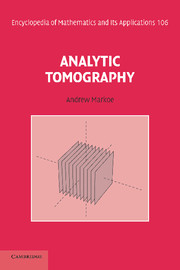Book contents
Introduction
Published online by Cambridge University Press: 24 October 2009
Summary
This book is about tomography, which is a way to see what is inside an object without opening it up. If you are intrigued with this idea, then, no matter what your background, you will find that at least some portion of this book will provide interesting reading. If this idea is not intriguing, then I would recommend some other publication for your reading pleasure.
The unifying idea of tomography is the Radon transform, which is introduced in an informal and graphic way in chapter 1. Reading chapter 1 will give you a good idea of the precise meaning of tomography. Reading chapter 2 will give you a very good idea of the meaning of tomography and if you read the last few chapters you will have a really good understanding of this idea. However, some of the later chapters will only be accessible to specialists.
I tried to write this book with two main ideas in mind. I wanted it to appeal to the broadest possible group of readers and I wanted it to be as comprehensive as possible. Therefore, chapter 1 has almost no mathematics in it – at least it does not require the reader to have any background beyond a good course in secondary school mathematics. CT (computerized tomography) scanners are used for medical diagnosis and produce detailed pictures of the human anatomy without opening up the patient. The dedicated reader will learn, in a very graphic way, how a CT scanner works.
- Type
- Chapter
- Information
- Analytic Tomography , pp. 1 - 5Publisher: Cambridge University PressPrint publication year: 2006
- 1
- Cited by



